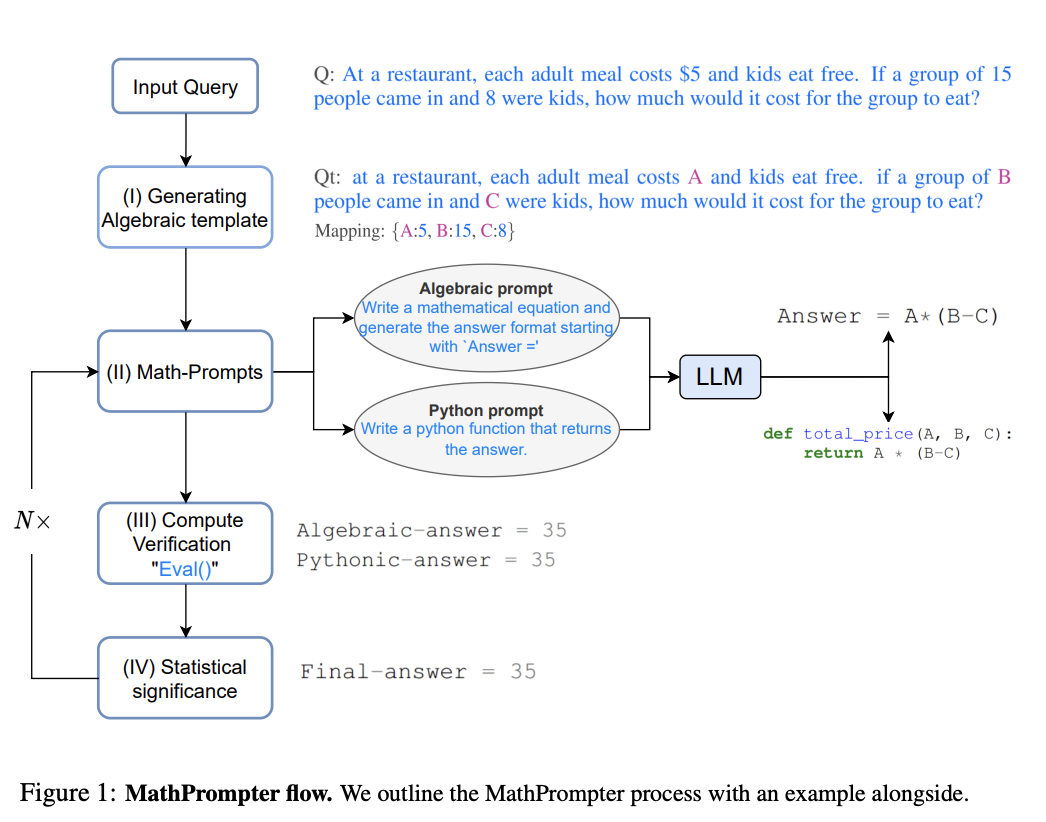🟡 Math
Throughout this course, we have seen many different prompting methods that can be used to improve LLM math ability. One recent approach, MathPrompter1, unifies some of these methods (CoT, PAL, etc.) into a single technique. The overarching idea is to break down a math question into algebraic terms then use Python code to solve it in different ways.

MathPrompter has four steps. We will explain them using the following example problem. The example is taken directly from the paper.
Q: At a restaurant, each adult meal costs $5 and kids eat free. If a group of 15
people came in and 8 were kids, how much would it cost for the group to eat?
Step 1: Generate Algabraic Template
The first step is to assign a variable to each number in the question. This helps because it allows easier translation of the question into an abstract math question, as well as into programming code.
This can be done via few shot prompting:
Step 2: Math Prompts
The point of this step is to formulate the problem as both an algabraic statement and as Python code. This step has two simultaneous prompts, which help to give diverse representations of the problem.
2a: Algebraic Statement
We can few-shot prompt the LLM to represent the math problem as an algebraic statement. This is done by asking the LLM to generate the answer format, starting with "Answer =".
2b: Python Code
We can also ask the LLM to generate Python code that solves the problem. This is done by asking the LLM to generate a Python function.
Answer Generation
Now, we can use the Mapping that we generated previously to automatically fill in the variables.
Mapping: {A: 5, B: 15, C: 8}
Algabraic:
Answer = 5 * 15 - 5 * 8
Python function:
def restaurant_cost(A=5, B=15, C=8):
return A * (B - C)
We can evaluate both using Python.
Algebraic:
>>> eval("5 * 15 - 5 * 8")
35
Python function:
>>> restaurant_cost()
35
Step 4: Self-Consistency
Finally, we will leverage Self-Consistency to rerun the above process multiple times (~5), then take the majority answer.
Conclusion
MathPrompter reports 92.5% accuracy on the MultiArith2 dataset. The success of this technique is a great example of how you as a prompt engineer can take methods that you have learned throughout this course and combine them to deal with larger problems.
- Imani, S., Du, L., & Shrivastava, H. (2023). MathPrompter: Mathematical Reasoning using Large Language Models. ↩
- Roy, S., & Roth, D. (2015). Solving General Arithmetic Word Problems. Proceedings of the 2015 Conference on Empirical Methods in Natural Language Processing, 1743–1752. https://doi.org/10.18653/v1/D15-1202 ↩